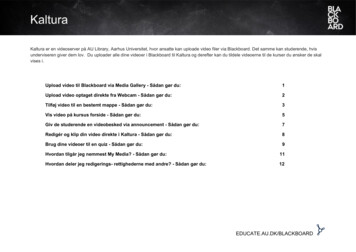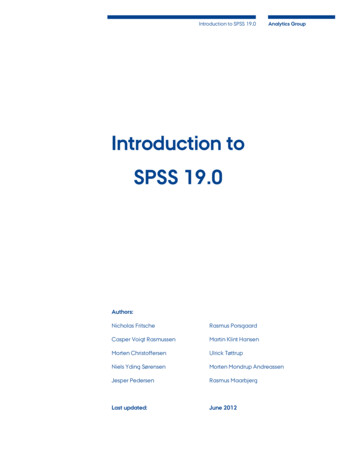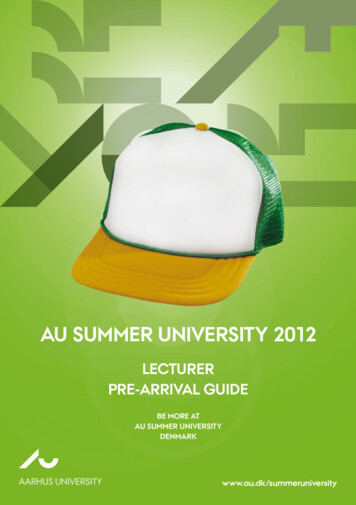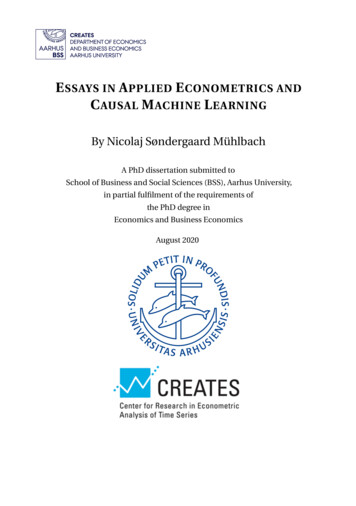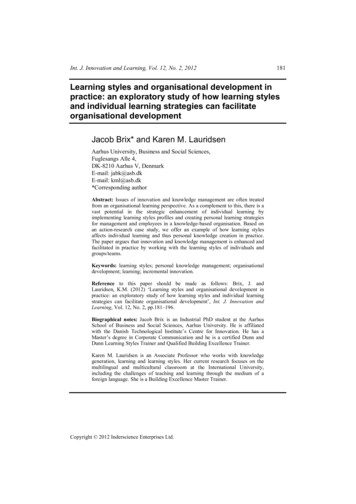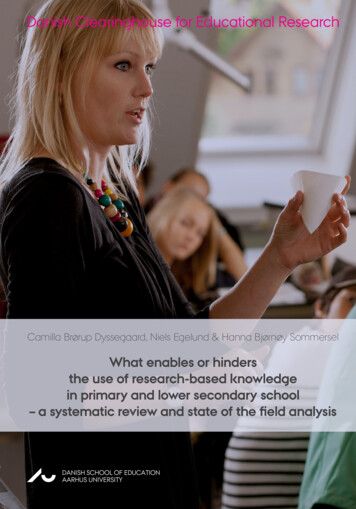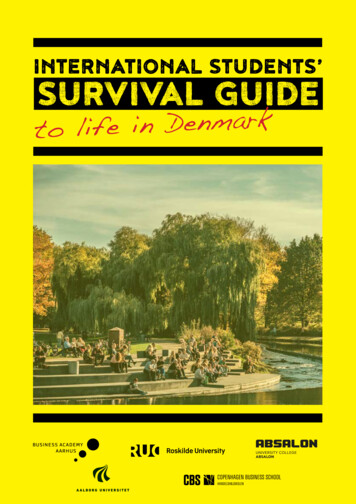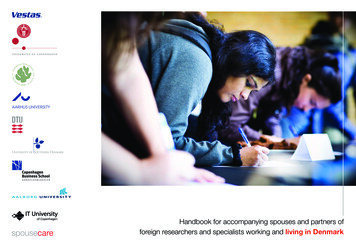
Transcription
university of copenhagenauAARHUS UNIVERSITYHandbook for accompanying spouses and partners offoreign researchers and specialists working and living in Denmark
Content21. Introductionpage32. Practical Information2.1 About Denmark2.2 Registration & CPR number2.3 Health Care in Denmark2.4 Banking, NemKonto, NemID and e-Boks2.5 Insurance2.6 Childcare and Schools2.7 Transportation2.8 Learning Danish2.9 Tax in Denmark2.10 Understanding Your Payslip2.11 Public Holidays2.12 Leisure Activities2.13 About Your agepagepagepage444567891111121314143. Danish Society and Culture & the DanishWork Culture3.1 In General3.2 The Danish Work Culture3.3 The Danish Labour Marketpagepagepagepage161620214. J ob Search & Starting Your Own Business4.1 Different Ways to Find a Job4.2 Starting Your Own Businesspage 23page 23page 255. Studying in Denmark & Applying forResearch Funds5.1 Studying in Denmark5.1.1 The Danish Education System5.1.2 Recognition of Foreign Qualifications5.1.3 Tuition Fees5.1.4 Where to Study5.1.5 How to Apply5.2 Research Funding5.2.1 Finding Research Foundations5.2.2 Danish Public Research Foundations5.2.3 EU Foundations5.2.4 General page6. Useful Linkspage 407. Short Vocabularypage 41Written & Edited by: Spousecare · Graphic Design and Layout: Datagraf & Jan Pemann · Photos: From the partners behind the project282828303031313232333636
31. IntroductionWelcome to Denmark!The overall purpose of this handbook is to give support and guidanceto accompanying spouses and partners of foreign researchers andspecialists who have moved to Denmark.In this guide, you will find practical information that will help yousettle down in Denmark and integrate into your local community. Youwill also find information on specific topics that can help you if youwould like to find work, study, start your own business or apply for aresearch fund.During 2011, there will be a variety of courses offered in Zealand(Sjælland), Jutland (Jylland) and Funen (Fyn) about work culture,studying in Denmark, job search, starting your own business or howto apply for a research fund.We hope that this handbook and the courses offered in 2011 will helpyou get a better understanding of the Danish lifestyle, work cultureand the opportunities that you can enjoy during your stay in Denmark.The partners behind this project are the universities in Denmarkin collaboration with Vestas and Spousecare. The project isfinancially supported by The National Labour Market Authority(Arbejdsmarkedsstyrelsen).
2. Practical Information42.1 About DenmarkDenmark consists of the peninsula of Jutland (Jylland) andapproximately 407 islands of which 79 are inhabited.* In the cities of Copenhagen, Aarhus, Odense and Aalborg, you canalso go to the International Citizen Service Office to get both yourresidence permit and a CPR number.The largest and most densely populated islands are Zealand(Sjælland), Funen (Fyn) and Bornholm. The capital Copenhagen(København) is situated on the east coast of Zealand.It is important to get the CPR number and the yellow health cardwhich will ensure that you can get free medical help, open a bankaccount, allow registration at the tax authorities, use public libraries,and many more services. You need to present your CPR number atalmost all official offices and banks in Denmark.Administratively, the country is divided into 5 regions (regioner) and98 local municipalities (kommuner).Towards the end of the 10th century, Denmark was united as a singlekingdom. It has been an independent country ever since, and is thusone of the oldest states in Europe.The form of government is a parliamentary democracy with a royalhead of state.2.2. Registration & CPR numberOnce you have received your residence permit* you can getregistered at your local municipality. In order to receive a CPR number(social security number) and a health card you need to:It is very important that you have the original documents from yourhome country (birth certificate, marriage certificate, driver’s licence,medical file, professional certificates, diplomas, etc.).Also, remember that if you want to extend your residence andwork permit, you have to apply for an extension by submitting yourapplication no sooner than 2 months before your original residencepermit expires. It is crucial thatyou submit your application foran extension before your currentresidence permit expires,otherwise you will be consideredas residing illegally in Denmark.Read more øje Tåstrup45.553VallensbækIshøj 12.26020.668Syddjurs40.196Please remember to put yourname on your door or mailboxso that the postman can deliveryour orgHillerød 18GladsaxeHerlev 1 Apply in person at the Citizen Service Office (Borgerservice) in themunicipality where you live and take with you your:– Residence permit and work permit– Passport– Marriage certificate and children’s birth certificates, if and49.469Guldborgsund63.533Anm.: Grænsejusteringer, som følge af lokale folkeafstemninger, er indikeret på kortet (menikke eksakte)Dragør13.156
2. Practical Information52.3. Health Care in DenmarkOnce you have received your CPR number and the yellow healthcard, you are covered by the Danish public health care system.We call the yellow health card“Sundhedsskort” in Danish.On your yellow health card, your name,address and CPR number are writtenas well as the name, telephone numberand address of your doctor/GP (generalpractitioner). A GP is called “læge” in Danish. You can contact yourGP during their office hours (usually in the morning) to make anappointment. Some GPs are members of an online appointmentbooking system: www.min-laege.dk (in Danish). You can also searchfor GPs in your area through this website. You are free to chooseyour GP among all the ones that work in your municipality. In caseyou later want to change GPs, this can be done once a year (somemunicipalities charge a fee to replace the yellow health card).EmergencyIn acute life-threatening emergencies such as fire, grievous bodilyassault and acute illness, call 112.In case of emergency call 112Doctors on Call (”Lægevagten” in Danish)If you need to get in touch with a GP outside office hours, you cancall “Lægevagten” which is a service line where you can talk to aGP who can help you decide how to proceed. If needed, the GP cansend a prescription directly to one of the pharmacies that are open24/7, where you will be able to pick up the medication.The “Lægevagten” service is open from 4 p.m. to 8 a.m. on weekdaysand 24 hours on Saturdays, Sundays and on holidays. Remember tohave your CPR number ready when you call.Here are the telephone numbers of the Doctors on Call in yourarea:Copenhagen Region (except Tårnby and Dragør)44 53 44 00Frederiksberg, Tårnby and Dragør70 13 00 41Former Frederiksborg Amt48 25 00 41Bornholm56 95 22 33Mid-Jutland Region70 11 31 31North-Jutland Region70 15 03 00Zealand Region70 15 07 00South-Denmark Region70 11 07 07PoliceIf you need to contact the police, you can call 114. You will beconnected to the police station nearest you. However, in anyemergency, it is still better to call 112.Having a babyAsk your GP about the pregnancy programme. Your GP will offer toenrol you in the public pregnancy programme in Denmark.DentistsDental care is free for children under 18. For adults, dental care inDenmark is not free but still subsidised by the government.
2. Practical Information62.4 Banking, NemKonto, NemID and e-BoksBankingIt is necessary to have a Danish bank account when living inDenmark. In most cases, you need it to receive your salary as wellas other supplements from the municipality which are paid directlyinto your bank account, such as child benefit (which is usually paidto the mother) and pensions. Once you have your CPR number, youcan go into any bank and open an account. Once you have a bankaccount, you can arrange to have your bills paid automatically fromyour account by direct debit (Betalingsservice). This service is freewhereas banks usually charge a service fee of at least DKK 20 if youpay your bills in person at the bank.When you open a bank account, the bank will issue you with a Danishdebit card which you can use to withdraw money at your bank, atthe bank’s cash point machines/ATMs and at most shops. Your bankmight charge a fee for withdrawing money from other banks’ ATMsso ask your bank before doing so. The most common debit card isthe “Dankort” which is valid for payments all over Denmark. You canuse the card to withdraw money and to pay for goods in most shopsas well as for internet shopping. You will be sent a PIN code whichyou will need in order to use the card at cash point machines and inshops. Some shops require a signature instead of a PIN code.You can use your debit card to withdraw cash in supermarkets.Typically, before you pay, the cashier will ask you if you want to paythe exact amount by saying “på beløbet.” You can ask for any extraamount, thereby using your debit card to withdraw money.Many banks offer a combined Visa/Dankort card. With a Visa card,you can pay for goods and services and withdraw money in mostparts of the world.“Netbanking” is widely used in Denmark and many banks offer thisservice in English. Please ask your bank for further details.Most shops and other service providers have the right to imposea surcharge for transactions made with foreign credit cards. Thissurcharge varies between 2% and 5% and is determined by theindividual store or chain.NemKontoMost residents in Denmark occasionally receive payments of somekind from the state. These payments can be tax refunds, childsubsidies, pensions, student loans, unemployment benefits, housingsupport or social welfare payments.Everybody in Denmark – citizens and companies alike – must havea designated NemKonto Easy Account, which is basically the bankaccount where you receive your salary. You must choose one accountas NemKonto if you have several bank accounts. Read more aboutNemKonto Easy Account here.If you are in doubt whether you have a ”NemKonto” or you do notknow which one of your accounts it is, then ask your bank and theywill let you know.
2. Practical Information7NemIDNemID is the new digital signature that all residents in Denmark havereceived in 2010. The purpose of NemID is for all residents to haveone internet login for all public and private services.The way you log in will always be the same, whether you areaccessing your online banking, e-Boks or the local public authorities’self-service, or whether you are checking your insurance or retrievingyour tax return from the Danish tax authorities, SKAT. Read moreabout NemID here.e-Bokse-Boks is your personal digital mailbox. You can choose to havedocuments from governmental institutions delivered in your e-Bokssuch as your pay slip, documents from ATP, SKAT (tax), banks,insurance, labour unions, etc. In addition, you can scan your birthcertificate or other personal papers and save them in e-Boks. Unlessyou erase them yourself, your documents in e-Boks will be kept foran unlimited period whether you move, get another job or changee-mail address. Through the internet, you always have access toyour documents, and you do not have to organize and file yourdocuments.Privacy and securitye-Boks is connected to your CPR number, i.e. only you have accessto your personal documents. All the information sent to you willbe encrypted so that nobody else can see it. Furthermore, e-Boksis using an approved certificate, which is your guarantee that youcommunicate with the right receiver i.e. e-Boks. All content is placedand stored in one of Denmark’s most secured servers at KMD. To logon to e-Boks, you need to have NemID. Unfortunately, the Englishguide on how to open an e-Boks has not yet been updated.2.5. InsuranceIn Denmark, two types of insurance policies are compulsory: Car insurance Third party liability insurance for dogs.Car InsuranceIf you buy a car in Denmark, you must take out Third Party LiabilityInsurance as it is compulsory in Denmark. The insurance coversliability for claims resulting from the car being used as a vehicle. Inaddition, you may choose to take out comprehensive car insurancewhich will cover any damage to your car and loss in case of theft.You can take out insurance with or without deductible. If you take outinsurance with deductible, your yearly fee will be lower than insurancewithout deductible but the deductible amount will apply to each andevery claim.Third Party Liability Insurance for DogsOwners of dogs must take out third party liability insurance coveringdamage or injury caused by the dog.Household Contents InsuranceA very useful insurance available in Denmark is the Household ContentsInsurance - the Comprehensive Family Insurance. It covers loss of anddamage to personal effects, furniture and other household contentsresulting from fire, theft, burglary and water damage. It also covers yourpersonal liability and when you are travelling, your luggage is covered.
2. Practical Information8Bicycles are only covered when they are locked with an approvedlock. The lock certificate must be kept as proof and must bepresented to the insurance company in case of theft. You also have tostate the frame number of the bicycle.leave is over (6-12 months), children go to day care or nursery untilthey are 2 years and 10 months old. After that, most children go tokindergarten or preschool (“børnehave” in Danish) until they startschool at around 6 or 7 years old.Buildings InsuranceThe Buildings Insurance/House Insurance covers: Fire and damage to buildings Attack by dry rot, fungi and insects Broken glass and sanitary fixtures Extended piping/cable insuranceDepending on which city you live in, you should expect waiting listsfor childcare so you should get organised and apply early.Insurance cover is provided on the basis of full rebuilding valueprovided that the house is sufficiently maintained. If you live in arental apartment or house the owner of the property is responsible forthe building insurance.Personal Accident InsuranceThe insurance covers accidents. Cover is normally provided if youbecome more than 5% permanently disabled.For more information, please see: CitizenInDenmark or contact yourlocal citizen service office.Children at SchoolMost Danish children who have reached school age (approx. 6) go tothe public school nearest their home. The school year starts in Augustand ends at the end of June. In general, children start school in thecalendar year when they have their sixth birthday. As a general rule,there is a space for your child in the school that is nearest to whereyou live. However, if there are places available in other schools, youhave the right to choose.Travel InsuranceRemember that you are not automatically covered if you travel withyour partner on business. Check with your insurance company whatcover applies to you.If you would like your children to attend a Danish public school, youcan contact your local citizen service office. They will inform youabout which schools in your municipality offer enrolment in specialclasses for children who do not speak Danish. In Danish, we callthese classes “modtagerklasser,” which literally means “receptionclasses.”2.6 Childcare and SchoolsSmall ChildrenIn Denmark, most parents work and they place their children in anursery, day care or kindergarten during the day. Once the parentalIf you are looking for an international school, there are 17 internationalschools in Denmark. You will find them here.
92. Practical InformationThere are also 15 international upper secondary schools, whichprimarily offer the International Baccalaureate (IB) and you will findthem here.After school hours, there are a number of caretaking possibilitiesdepending on which city you live in. Most schools have an afterschool “club” for children. You need to pay separate fees for theseclubs. The caretaking and youth school activities are typically locatedat or near the children’s school.2.7 TransportationTrains & MetroThere are several railway companies in Denmark. DSB is the biggestone and is owned by the Danish Ministry of Transport. DSB trainscover the whole country and DSB S-tog cover all suburban railservices in the greater Copenhagen area.DSB Customer Centre: ( 45) 70 13 14 15.The welcome message is in English and the staff can speak English.Here you can book or buy tickets, get information about train servicesor other information about DSB.In Copenhagen, you can also use the METRO. For further information,click here.To read more about public transportation in Copenhagen, click here.
2. Practical Information10BusesThere are a lot of different bus companies operating all over Denmark.However, very few of them have an English website. In Frederiksberg,Roskilde and Copenhagen, the buses are run by a bus companycalled HUR.ChildrenA child under the age of 12 travelling alone must pay the child fare(until age 16), which is approximately half the price of an adultfare. Up to two children under 12 years old can travel free whenaccompanied by an adult with a valid ticket or travel card. Up to fourchildren under the age of 12 can travel together on one adult ticket.TimetablesYou can see the timetables at the bus stops, at the S-stations andonline:BicyclesMost Danes own a bicycle and Danish children learn to cycle at ayoung age. 36% of commuters go to work by bike in Copenhagen.Cycling is widely practiced across the country due to the many cyclelanes that provide a safe and secure environment for cyclists. Youmay notice that a large number of cyclists wear helmets. Doing so isnot compulsory (yet) but it is strongly advised especially for children.For more information about cycling in Denmark, click here.Cars and Motorcycles in DenmarkWhen driving a car or motorcycle in Denmark, you always need tocarry with you a valid driver’s licence. Seatbelts are compulsory for allpassengers including the driver and if you have young children in thecar (under 135 cm), they must always use an approved child seat orbooster seat which is appropriate to the child’s age, size and weight.To learn more about the Danish traffic rules, click here.S-trains: http://www.dsb.dk/Buses: http://www.moviatrafik.dk/Pages/home.aspxEnter the bus number under ”Find din køreplan” (Find your timetable).Note that there are different timetables for weekdays, Saturdays andSundays/Holidays.Planning Your TripGo to http://www.rejseplanen.dk/ and plan your trip from A to Bincluding a list of all changes and number of zones. This site is inDanish, English and German.When you drive a car in Denmark, it may be necessary to have yourforeign driver’s licence exchanged for a Danish one. Read about therules here.If you are bringing a vehicle to Denmark, you need to register it. Readabout the rules here.
2. Practical Information112.8 Learning DanishEvery newcomer who is registered at the National Register of Persons(Folkeregistret) and who has a residence permit and CPR numberhas the right to take Danish language lessons for 3 years. Yourlocal municipality (kommune) is responsible for coordinating Danishclasses, either by organising them on their own or by referring peopleto private language schools.There are many courses and schools where you can learn Danish.There are day courses and evening courses at all levels. Once youhave received your CPR number, you are free to join classes thatare offered at language centres located nationwide for a small feeper module. The three Danish language courses are divided into sixmodules and are completed by passing a final Danish proficiencytest. This must take place within a three year period, which canexceptionally be extended in certain cases such as pregnancy or longleave of absence.If you have not yet moved to Denmark, or if you do not have a CPRnumber, you can try some of the online Danish courses. Read moreabout this at www.newtodenmark.dk.You can find a short vocabulary to get you started in section 7.Supermarkets in Denmark:Here are the most common supermarkets in Denmark: Aldi, Lidl – the cheapest discount supermarkets Fakta, Netto, Rema1000 – discount supermarkets Føtex, Superbrugsen, Kvickly, Superbest – some of thesesupermarkets have bigger branches where they sell fresh fish, havea bakery and a butcher Irma – the most expensive supermarket chain with lots ofspecialised products.2.9 Tax in DenmarkThe tax system incorporates many rules and laws and even thoughyou do not need to know all of them, you will inevitably need to knowthe basics about the tax system.Almost all young people and adults living in Denmark pay tax,irrespective of whether they have a job, are students or unemployedor whether they receive money from the state or a municipality. Twicea year, everybody receives a letter from the Danish tax authority –SKAT – asking them to check and approve figures. It is thereforeuseful to know a little bit about the tax system and what yourresponsibilities are.Why Pay Tax?The Danish welfare state is, among other things, based on the conceptthat residents should have equal access to the different services paidfor by taxes. Everybody must be able to get help in difficult situations,for example, in case of unemployment or serious illness. In thesesituations, residents must be able to obtain financial assistance,medical help, hospital treatment, etc. All children are required toattend ten years of schooling and have the possibility of getting highereducation, all paid for by the state. The tax rate is one of the highest inthe world as Denmark has a very large public sector that offers manyservices that people in other countries often have to pay for.
2. Practical Information12To help you get to grips with taxes in Denmark, you might find thefollowing links helpful:In Denmark, it is possible to deal with tax electronically. You can readmore on the e-tax card here.Between 10 March and 15 April each year, SKAT will send you anannual tax statement and an information card. You must check thefigures on your annual tax statement and report any changes oradditions. You can read more here.SKAT has a special tax scheme for researchers and key employeesrecruited from abroad. You can read more here.You can obtain tax deductions if you travel to work by car or publictransport, depending on the distance travelled. Read more aboutwhich rules apply here.If you are looking to register your own car in Denmark, you can readmore here.At workindenmark.dk, you can read more about advice on taxationfrom experts and you can also find more information about tax here.2.10 Understanding Your PayslipHow to Read Your Danish PayslipPayslips vary in appearance, but will usually contain the sameinformation: How much you have to pay in tax, different pensioncontributions and what your net salary is.Here are explanations of some of the Danish terms on your payslip:Løn / Pay:It can also be stated as “Honorar” (fee) or “indtægt” (income). Yourgross pay is usually stated at the top of the payslip. At the bottomof the calculation, the following is usually stated: “Løn til udbetaling”(Pay for disbursement), showing the amount of your net pay that willbe paid directly into your account.(ATP) Arbejdsmarkedets tillægspension / Labour MarketSupplementary Pension Fund:All employees between the age of 16 and 66 pay to this pensionscheme. The amount is deducted from your gross pay before yourtax is calculated. Your employer will equally have to pay a monthlyamount to your ATP account.Arbejdsmarkedsbidrag / Labour Market Contribution:All working citizens must contribute to a labour market fund at a rateof 8 percent. The contribution is deducted from your gross pay afterATP has been deducted and before other allowances are deducted.Then, your tax is calculated.Fradrag / Allowances and Deductions:Your allowances corresponding to the pay period are deductedbefore tax is calculated. On your tax card, your employer can seeyour allowances and deductions which are, for example, interest onloans, transportation allowances, etc.
2. Practical Information13A-skat / A tax:This is the tax which is charged on your A income, i.e. your ordinaryincome. Your employer will calculate your A tax based on yourwithholding rate.Ferie / Holiday:All employees are usually entitled to holiday pay. This means that inaddition to your pay, you will receive on a monthly basis 12.5 per centof your gross salary which is deposited into a holiday account andpaid out to you when you go on holiday. Every time you receive yourpayslip, you should check that the figures are correct. You shouldalso save your payslips until the end of the tax year and until your taxfor the year has been calculated (on the annual tax statement). Yourpayslips are proof that you have paid tax.Holidays and Holiday PayAll employees in Denmark are entitled to five weeks’ holiday duringevery “holiday year.” The holiday year runs from 1 May to 30 April.If an employee has worked for an entire calendar year prior tocommencement of the holiday year, he/she has earned the right tofive weeks’ paid holiday from his/her employer, either in the form ofpaid salary during the holiday or a holiday allowance.If the employee has only been employed for a short time, 2.08 holidaydays are earned per month of employment.If the employee has not earned the right to five weeks’ paid holiday,he/she still has the right to take up to five weeks’ non-paid holiday. You earn paid holidays in the calendar year from 1 January to 31December You earn 2.08 paid holidays per month of employment You take paid holiday in the subsequent year (vacation year) form 1May to 30 April.Example:You started employment on 1 April 2010.You earned 2.08 days * 9 months approx. 19 days of paid holidayin 2010. You can take 19 days of paid holiday from 1 May 2011 to 30April 2012. In case you want to take more holidays (up to 25 days),you will have to pay for these yourself by taking a pay cut.Planning HolidaysNormally, holiday dates are mutually agreed between the employerand the employee. All employees have the right to three weeks’uninterrupted holiday between 1 May and 30 September (primaryholiday). Notice of this holiday must be given 3 months in advance;notice of other holidays must be given 1 month in advance.2.11 Public HolidaysIn addition to the work holidays described above, Denmark has anumber of public holidays (bank holidays) every year. Some of thedays vary from year to year. Below you can find a list of the publicholidays for the next 4 years. Please note that Constitution Day(5 June) and Christmas Eve (24 December) are not always consideredbank holidays at private companies.
2. Practical Information142011201220132014New Year’s Day1 January1 January1 January1 JanuaryMaundy Thursday21 April5 April28 March17 AprilGood Friday22 April6 April29 March18 AprilEaster Monday25 April9 April1 April21 AprilGeneral Prayer Day 20 May4 May26 April16 MayAscension Day2 June17 May9 May29 MayConstitution Day5 June5 June5 June5 JuneWhit Monday13 June18 May19 May9 JuneChristmas Eve24 December24 December24 December24 DecemberChristmas Day25 December25 December25 December25 DecemberBoxing Day26 December26 December26 December26 DecemberPlease note that most shops, banks, restaurants and museums areclosed on these days.2.12 Leisure ActivitiesDenmark is a country with many clubs and associations. There aremany activities that you can enjoy in your spare time.We recommend that you join a club or an association of your interestas this is also a great way to meet Danes. Check with your localmunicipality and explore the options.If you wish to join a network to meet other expats, we recommendExpat in Denmark www.expatindenmark.com. They organise eventsall over Denmark and they are the national Danish network for expatsand their families living and working in Denmark.Other networks for foreigners are: Spousecare – events in the Copenhagen Area LINK – Ladies International Network in Copenhagen Worktrotter – a network by expats for expats International Community – a network for expats in Aarhus2.13 About Your HouseholdDrinking WaterAll tap water in Denmark is clean drinking water: in restaurants,cafés, shopping centres, stores, private homes, offices and even inpublic restrooms. Dirty/contaminated water is very rarely encounteredanywhere in the country.CleaningThe water in Denmark is very hard, in other words it contains a largeamount of calcium and can leave a white residue most noticeable onbathroom tiles and faucets. To remove this limescale residue, you willneed a cleaning liquid containing a special type of vin
2.3 Health Care in Denmark page 5 2.4 Banking, NemKonto, NemID and e-Boks page 6 2.5 Insurance page 7 2.6 Childcare and Schools page 8 2.7 Transportation page 9 2.8 Learning Danish page 11 2.9 Tax in Denmark page 11 2.10 Understanding Your Payslip page 12 2.11 Public Holidays page 13 2.12 Leisure Activities page 14
